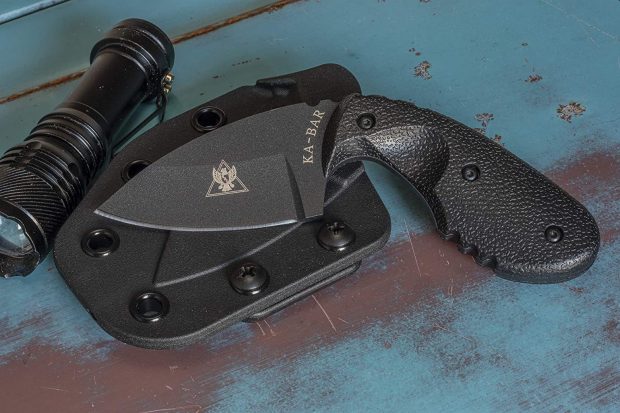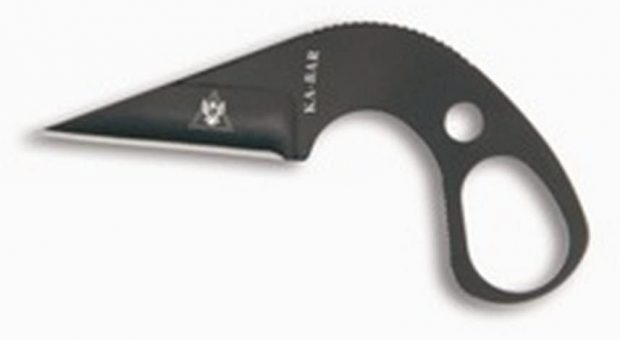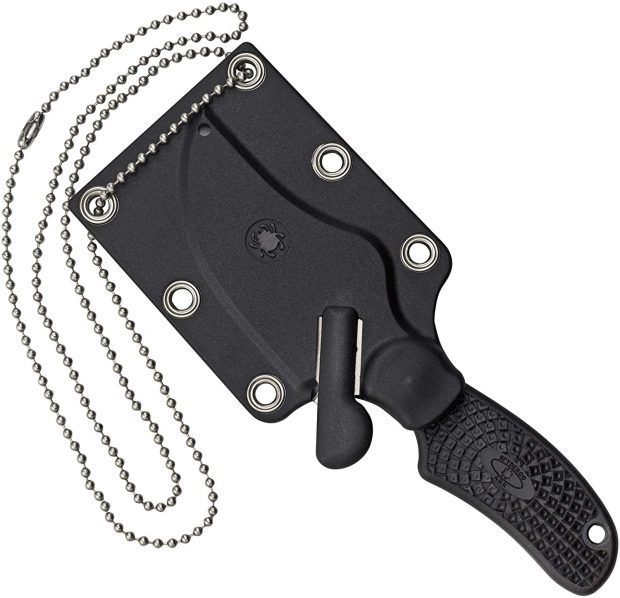Written by: Greg Ellifritz
I recently received an excellent question from a reader. It’s a valuable topic so I decided to address it in this public forum rather than simply replying to his email.
“I have been reading your blog for several years and been impressed by the content.
If you have some spare time I would like some advice/guidance. I am currently currently in law enforcement (agency redacted) and am looking to add a defensive knife to my setup. Primarily for a gun grab or other entangled situation.
I have a Kabar TDI I received as a gift but am hesitant it may be too easy for an attacker to take it off my belt. I have seen a news story where that exact situation happened to an officer in Texas, although I don’t know the exact details on what happened.
I have also looked at the Shivworks Clinch Pick. I really like the purposeful effectiveness of the design but I am uncertain how it would work behind a duty belt or in a pistol retention scenario as opposed to the CCW/undercover officer role it was designed for.
As a recently retired LEO, what would be your advice and guidance on the best option and the pros/cons of each? Or how to adapt them for duty use?”
I have a lot of experience with the two knives he mentioned.
I was working at TDI when John Benner designed the Ka-Bar TDI Law Enforcement Knife. I provided some comments on the initial design and did some testing of the first prototypes. Along with Mr. Benner, I developed the first police knife class ever taught at OPOTA, our state police academy. We based the class curriculum around the TDI Knife. I instructed that particular class for six years and was the lead instructor for TDI’s knife fighting classes for 14 years.
I also have some experience with the Clinch Pick. I took two of the designer’s (Craig Douglas) knife classes. I took “In-Extremis Knife” and Craig’s two day “Edged Weapons Overview” using the Clinch Pick and its trainer. I’ve also taken Shivworks Collective member Chris Fry’s “Practical Small Knife Skills” class.
I’ve talked extensively with both John Benner and Craig Douglas about their respective knife designs and believe that I have a good understanding of the design principles and how both guys envision their blades being used.
I think it’s important to recognize that both men designed their knives contemporaneously to solve the exact same problem of an entangled fight and/or close range gun grab attempt. The difference in execution is a function of who each knife was designed for. John designed the TDI knife explicitly for the uniformed police officer. Craig was working undercover narcotics at the time he dreamed up the clinch pick and he optimized it for someone who was carrying concealed with an untucked shirt.
The upward draw orientation with the TDI knife is comfortable to carry behind a police duty belt. The downward angle of the Clinch Pick is quicker to access under an untucked shirt hem.
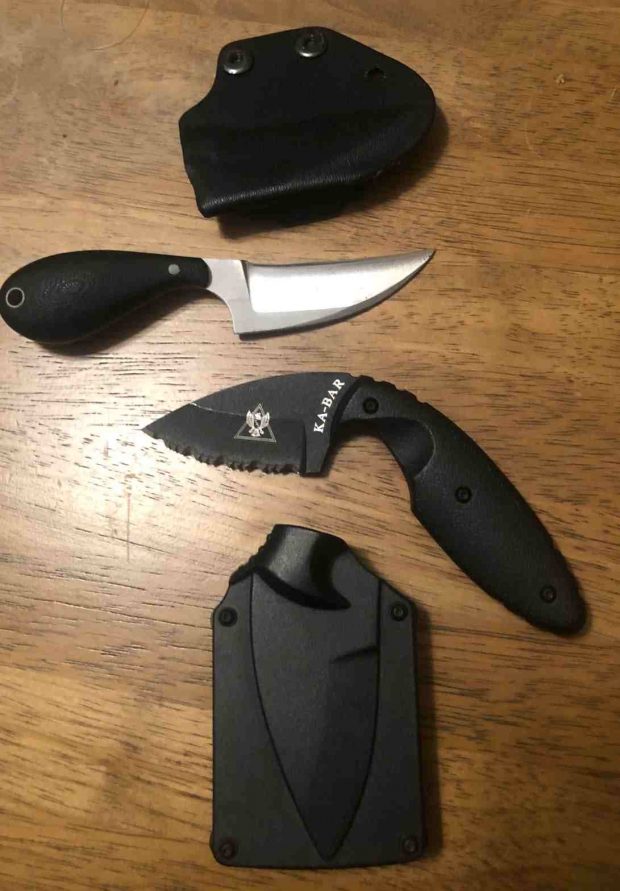
Clinch Pick with horizontal Keeper’s Concealment sheath and Ka-Bar TDI with factory sheath.
Neither sheath has any active retention features. Both depend on concealment for retention. The clinch pick should be covered by an untucked shirt. The TDI knife was designed to be hidden behind an officer’s vertical magazine pouches on his duty belt.
If the Clich Pick is worn in uniform, it would not be concealed at all and would be very vulnerable to a grab from a criminal suspect.
The factory TDI sheath doesn’t do a very good job completely concealing the TDI knife mounted behind the officer’s duty belt, but it’s somewhat better than the Clinch Pick. The officers I know who successfully hide the TDI use an aftermarket sheath. The best ones I’ve found are made by PHLster, Zulu Bravo Kydex, and NSR Tactical. Those sheaths ride lower in the waistband and hide the TDI knife better.
When the TDI knife was introduced, I wore it on duty. I carried it for a couple years, but even using aftermarket sheaths, it was too visible for my tastes. About 2008, I transitioned to the Emerson La Griffe mounted to the back of my magazine pouch. The La Griffe was slimmer and less visible.
I attached the sheath to my mag pouch with a single Chicago screw which allowed me to adjust the angle of the knife’s handle so that it was completely concealed by my magazine pouch yet still easy to draw. I wore my fixed blade knife in uniform like that until I retired in August.
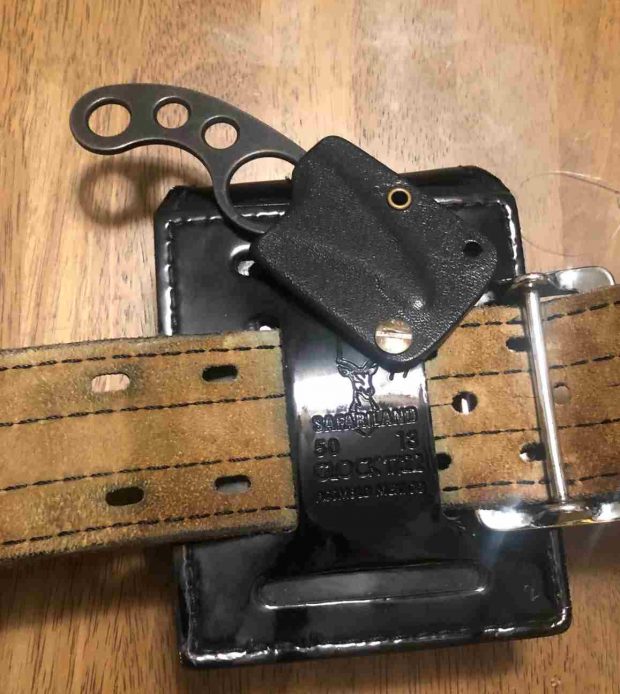
Well used Emerson La Griffe mounted to my magazine pouch
There are a couple other options to consider.
The newer TDI Investigator knife my work better for you. It has a better designed sheath and a smaller handle. It also rides lower than the standard TDI Knife.
You could also use the Ka-Bar Last Ditch knife I designed for ultimate concealability. It’s really small and would be unnoticeable mounted behind the magazine pouch. It’s not as big as I’d like for a primary defensive blade, but it could do the job if pressed into action.
If you want a small fixed blade knife held in a sheath with active retention, try the Spyderco ARK neck knife. The sheath would have to be directly mounted to your belt or mag pouch, but it has a lever that must be pushed to draw the knife from the sheath. It would be hard for a criminal to figure out how to draw that while in the middle of a fight.
One other option is to pick any small fixed blade knife and rig up a “slip sheath” attached to your under belt and thrust into your waistband.
Attach the cord on the sheath to your belt or belt loop and then position the sheath inside your waistband. When you draw the knife, the sheath falls off as soon as it reaches the end of the cord. If you need to have a lower profile, shove the knife completely down the front of your pants. The only thing visible is the cord attached to the belt, but that should be covered by your duty belt. If you use paracord that is the same color as your belt or your pants, the cord will be barely noticeable.
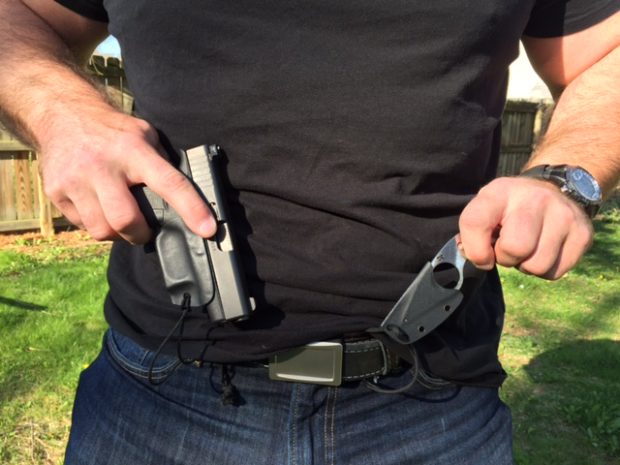
Fred Perrin custom La Griffe set up to be carried in a slip sheath.
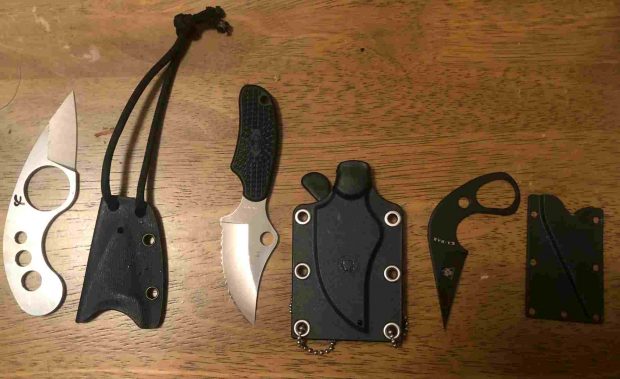
Perrin La Griffe (with slip sheath), Spyderco Ark, and Ka-Bar Last Ditch for size comparison.
For both uniformed cops and armed citizens alike, a small fixed blade knife carried center line on the body is a revolutionary game changer in a fight. In that position, it’s accessible to either hand in almost every body position possible.
I’ve timed students drawing a TDI knife and stabbing a target in times ranging between a half and three quarters of a second. That’s a faster draw than even the best shooting competitors can manage with their pistols.
I highly recommend that uniformed cops should carry a fixed blade defensive knife. There are many options available today. Pick one that is comfortable to carry, offers maximal concealment/retention, and carry it where it is accessible to either hand.
The bottom line? I really like the Clinch Pick, but I haven’t seen anyone who could successfully carry it concealed on the belt line in a police uniform. The Clinch Pick is a great choice for carrying concealed but I think other options are better for a uniformed officer.
Some of the above links (from Amazon.com and others) are affiliate links. As an Amazon associate I earn a small percentage of the sale price from qualifying purchases.
If you would like to further support my work, head over to my Patreon page.

